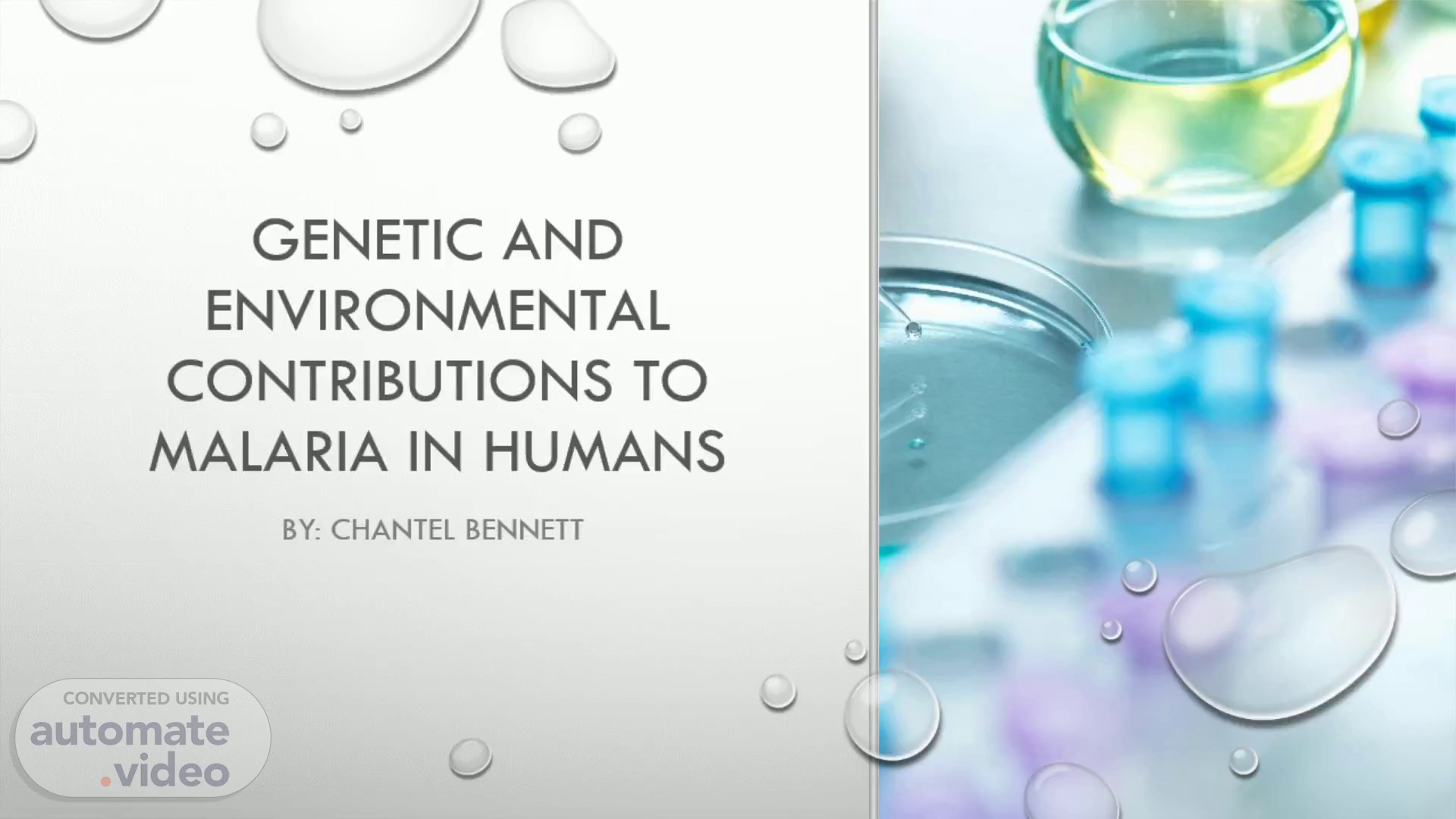
Genetic and Environmental contributions to malaria in humans
Scene 1 (0s)
[Audio] Genetic and Environmental Contributions to Malaria in Humans.
Scene 2 (9s)
[Audio] The Introduction Malaria– is a disease caused by a parasitic infection transmitted to humans by female mosquitos.
Scene 3 (23s)
Ross Model. explains the bite rate a person gets and the proportion of bites that produce an infection Limitations: it assumes investors are risk-neutral it relies on certain assumptions about the distribution of returns and correlations between assets. assumes that all investors have the same investment horizons and cash-flow needs.
Scene 4 (40s)
Macdonald Model (island model). explains the proportion of bites from a susceptible mosquito that becomes infected, the ratio of the number of female mosquitoes to humans, and the average recovery rate of humans. Limitations: assumptions of random mating, no selection, no mutation, no overlapping generations, and no geographic barriers to migration. assumes a constant population size, while most real-world populations fluctuate over time. only considers the effects of two alleles at a time, while many traits are influenced by multiple genes..
Scene 5 (1m 4s)
Anderson and May Model. explains the human mortality rate per capita, the mosquito mortality rate per capita, the latent period of the mosquito, and the latent period of humans. Limitations: assumes a constant transmission rate doesn't account for population heterogeneity doesn't account for changes in behavior or intervention measures.
Scene 6 (1m 20s)
Figure 4. Figure a: Graph a represents Variation in loss of immunity ( γ ) with force of infection ( h ), and immunity period ( τ ) in absence of new infections. Figure b: Graph represents Age-Prevalence curve simulated from Aron-May model for three different levels of force of infection (h). Other parameter values are r = 0.8, q = 0.2, and τ = 5..
Scene 7 (1m 40s)
This figure shows if lower intervention is used, shorter sleeping times, and increased attractiveness to mosquitoes, makes older children and adults considerably more likely to be fed on by anopheline vectors and thereby increase their plausible contribution to the human infectious reservoir for malaria if they are infectious to the mosquitoes..
Scene 8 (2m 5s)
improvements. Developing genetic tests to identify individuals who may be more susceptible to malaria, so that they can take steps to avoid infection or be treated more aggressively. Developing new genetic therapies or medicines that could boost the body's immune response to malaria or help prevent the disease from taking hold in the first place. Improving environmental factors such as water and sanitation, which can help reduce mosquito breeding and in turn decrease the transmission rates of malaria. Increasing access to mosquito nets, insecticides, and other preventative measures ..
Scene 9 (2m 30s)
conclusion. Improving public health measures such as mosquito control, increasing access to effective antimalarial drugs, and improving living conditions can all help reduce the burden of malaria in affected populations. The factors that influence susceptibility to malaria are complex and multifactorial and may vary depending on the specific type of malaria parasite and the environmental context in which the infection occurs. Ongoing research is aimed at identifying additional factors that contribute to the complex interplay between host genetics and malaria susceptibility. any effective approach to reducing malaria will require a multifaceted and integrated strategy that considers both genetic and environmental factors..
Scene 10 (2m 57s)
Science Lab. References. Kwiatkowski DP. How malaria has affected the human genome and what human genetics can teach us about malaria. Am J Hum Genet. 2005 Aug;77(2):171-92. doi : 10.1086/432519. Epub 2005 Jul 6. PMID: 16001361; PMCID: PMC1224522. Hedrick, P. W. (2011). Population genetics of malaria resistance in humans. Heredity , 107 (4), 283–304. https://doi-org.ezproxy.snhu.edu/10.1038/hdy.2011.16 Institute of Medicine (US) Committee for the Study on Malaria Prevention and Control; Oaks SC Jr., Mitchell VS, Pearson GW, et al., editors. Malaria: Obstacles and Opportunities. Washington (DC): National Academies Press (US); 1991. 1, Conclusions and Recommendations. Available from: https://www.ncbi.nlm.nih.gov/books/NBK234324/ Smith TA, Chitnis N, Penny M, Tanner M. Malaria Modeling in the Era of Eradication. Cold Spring Harb Perspect Med. 2017 Apr 3;7(4):a025460. doi : 10.1101/cshperspect.a025460. PMID: 28003280; PMCID: PMC5378013. Am J Trop Med Hyg . Author manuscript; available in PMC 2008 Jul 24. Published in final edited form as: Am J Trop Med Hyg . 2000 May; 62(5): 535–544. doi : 10.4269/ajtmh.2000.62.535.